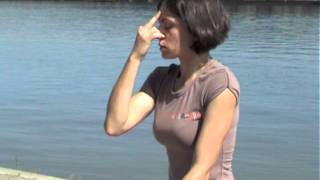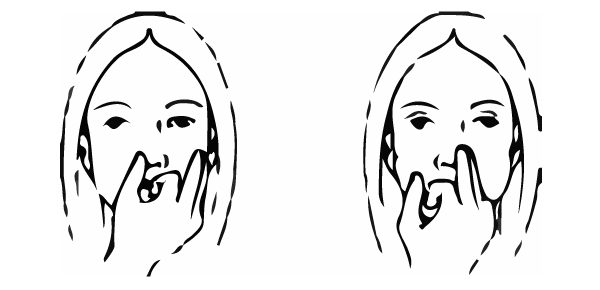 The word “Chandra” stands for the Moon and the meaning of Bhedan is piercing, enter or breaking through something e.t.c. and it is also known as Chandra bhedi pranayama. We have two nostrils for breathing, in yogic term these two nostrils are called nadi, Right nostril is Surya nadi and left nostril is known as Chandra nadi. There is another name for this Ida nadi (left nostril) and Pingala nadi (right nostril). Chandra Bhedana Pranayama is a simple and effective breathing technique. Moon is the symbol of coolness, so by doing this pranayama we feel some coolness in our body. Best and effective breathing process for cooling down the body. In this breathing exercise breathe in (inhalation) is done by the left nadi and we breathe out through the right nadi or right nostril. So this process is named as left nostril breathing or Anuloma type of pranayama. It is aforesaid that energy passes through Ida nadi (Chandra nadi) on the inhalation and by Pingala or Surya Nadi on the exhalation. These are larger nadis that hold the balance of magnetism and energy created by the sun and moon. They travel from the bottom of the spine to the purpose of the eyebrows.
The word “Chandra” stands for the Moon and the meaning of Bhedan is piercing, enter or breaking through something e.t.c. and it is also known as Chandra bhedi pranayama. We have two nostrils for breathing, in yogic term these two nostrils are called nadi, Right nostril is Surya nadi and left nostril is known as Chandra nadi. There is another name for this Ida nadi (left nostril) and Pingala nadi (right nostril). Chandra Bhedana Pranayama is a simple and effective breathing technique. Moon is the symbol of coolness, so by doing this pranayama we feel some coolness in our body. Best and effective breathing process for cooling down the body. In this breathing exercise breathe in (inhalation) is done by the left nadi and we breathe out through the right nadi or right nostril. So this process is named as left nostril breathing or Anuloma type of pranayama. It is aforesaid that energy passes through Ida nadi (Chandra nadi) on the inhalation and by Pingala or Surya Nadi on the exhalation. These are larger nadis that hold the balance of magnetism and energy created by the sun and moon. They travel from the bottom of the spine to the purpose of the eyebrows.
How to perform Chandra Bhedana Pranayama
- Choose a comfortable sitting asana like Swastikasana or Padmasana e.t.c sit comfortably.
- Make a pranayama mudra by your fingers (press the index and middle finger of your hand towards the palm).
- Now use your right thumb to shut the right nostril. (If you are left-handed then make the pranayama mudra with your left hand and shut the right nostril with index and middle finger of your left hand).
- Now inhale slowly and deeply through your left nadi until your lungs fill with maximum air.
- Now hold your breath for some time or as per your capacity.
- Breathe out (exhale) slowly through right nadi.(Exhalation should be longer than the inhalation)
- Repeat this process around 10 times.
Benefits of Chandra Bhedana Pranayama
- Helpful in reduces body heat.
- Useful in heart burning problems.
- Gives the refreshment to the body and mind and kicked out the feeling of laziness.
- Very effective in High blood pressure.
- Chandra bhedana pranayamaUseful in fever.
- Decrease the flow of gall.
- The mind becomes steady by the daily practice of this Pranayama.
- Useful in reducing the tension, stress and other mental problems.
Precautions
Do not perform Chandra Bhedana Pranayama in case of Asthama, low blood pressure, cough and cold, and problems related to the respiratory system. In the initial stage don’t hold your breath for 2 months. In the initial stage do only breathe in through the left nostril and breathe out by right nostril.
Maintain the ratio of inhalation, retention and exhalation as 1:4:2. For beginners do not hold your breath and keep the ratio 1:2 for inhalation and exhalation. Always take the advice of an expert person before doing any process of yoga. Perform pranayama with an empty stomach.
Other Breathing Techniques
- Bhastrika Pranayama
- Kapalbhati Pranayama
- Bahya Pranayama
- Anulom Vilom Pranayama
- Nadi Shodhana Pranayama (Alternate Nostril Breathing)
- Ujjayi Pranayama
- Udgeeth – (chanting the word Om)
- Pranav Pranayama
- Sheetkari Pranayama {Hissing Breath}-Steps And Benefits
- Sheetali Pranayama {Cooling Breath}-Steps And Benefits
- Chandra Bhedana Pranayama (Left Nostril Breathing)-Steps And Benefits
What is Pranayama
Also Visit: Yoga Poses

Thank u for the information.keep doing well for human being.
thank you for appreciating @Jitneder sherkane.
Which pranayam is recommended for severe anxiety and fear .
Anlom vilom, nadi Shodhana.
Agree with Deep. But add Bhramari to these even for 5 minutes will help you a lot. Bhramari ‘s main benefit is to reduce anxiety and depression.
@ Sai Prasad, thank you for your precious comment. You are right.
Anulom Vilom, Nadi Shodhana, Chandra Bhedana, Ujjayi, Udgeeth & Pranav Pranayama are best for anxiety. Iam also suffering from anxiety and i practice these Asana Mention by Sarvyoga. This will helps me a lot. Thank you Sarvyoga. keep doing well.
Thanks, Deep for your comment. Your appreciation boost our confidence & motivates us to do more hard work. We always trying to give our best.
Thank you & May God bless you.
When I inhale during chanderbhedi pranayam by left nostril, what should be the movement of stomach…. Whenever I inhale, my stomach movement towards inside…Is it right it wrong??